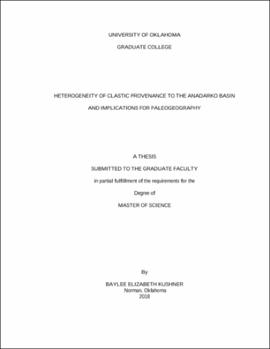| dc.description.abstract | Thin section petrography and U/Pb detrital zircon geochronology were used to reconstruct Middle-Late Pennsylvanian drainage pathways into the Anadarko Basin, and evaluating the relative proportion of sediment originating from the Wichita-Amarillo Uplift and the Appalachian Orogen. Framework mineralogy indicates three petrographic populations: quartzose and quartzolithic sandstone, and arkose. Concentrations of chert clasts and regionally distinct feldspar textures within these populations correlated with drainage patterns determined by detrital zircon provenance spectra and known regional paleotopography. Detrital zircon geochronology indicates four distinct provenance types during the Middle Pennsylvanian. The Wichita type contains a single age peak at 535 Ma that correlates with igneous rocks of the Southern Oklahoma Aulacogen and is present proximal to the uplift only. The Appalachian type contains a dominant 900-1300 Ma age peak that correlates to the Grenville Orogeny and is found east of the Anadarko Basin. The Paleo-Proterozoic type contains two dominant age peaks, which are correlated to Appalachian and Peri-Gondwanan basement rock, with a minor peak of Archean age attributed to Pan-African terranes on the eastern margin of North America. The Paleo-Proterozoic type does not contain a Grenville age peak and characterizes sandstone in northern Oklahoma only. The Mixed type contains a roughly equal number of zircons from each basement terrane present across the Anadarko Basin, and is found only in deep basin sandstone on the eastern and western corners of the Anadarko Basin. Arenites with a Mixed detrital zircon signature are differentiated by abundances of lithic components and are sourced from upslope sandstone on their respective sides of the basin. These spatially discrete petrographic and detrital zircon populations suggest partitioned drainage networks during the Middle Pennsylvanian that reflect complex local paleotopography and reactivated basement structures. In contrast, Late Pennsylvanian samples reveal that Appalachian-type sandstone is deposited uniformly across northern Oklahoma and into the deep Anadarko Basin, adjacent to Wichita-type proximal deposits. The Anadarko Basin’s high subsidence rate, unique in the region, facilitated capture of this local- to Appalachian-derived sediment transition between the Middle and Late Pennsylvanian. This sedimentation record allows high-resolution correlation with other basins on the North American continent to reconstruct Middle and Late Pennsylvanian sediment pathways to the Anadarko Basin. | en_US |
